NCERT Solutions for Class 7 Social Science Chapter 6 The Age of Reorganisation
The Big Questions (117)
Q1: Why is the period that followed the Maurya Empire sometimes called the ‘Age of Reorganisation’?
Ans:
- After the Maurya Empire fell around 185 BCE, many new kingdoms emerged across India.
- These kingdoms reorganized political power, creating new rulers, regions, and alliances.
- Foreign groups like the Indo-Greeks, Shakas, and Kushanas entered India and blended their cultures.
- It was a time of rebuilding, cultural exchange, and development in art, trade, and literature.
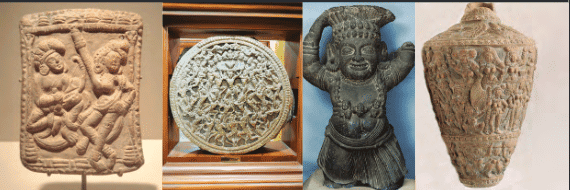 Glimpse of art from the age of Reorganization
Glimpse of art from the age of Reorganization
Q2: What were the values or principles that guided emperors of that period?
Ans:
- Many rulers supported all religions, including Vedic, Buddhist, Jain, and local beliefs.
- Emperors like Kharavela and the Satavahanas focused on public welfare, justice, and charity.
- They encouraged trade, learning, and art, building temples, caves, and cities.
- Rulers practiced fairness, inclusivity, and promoted harmony among diverse communities.
Q3: How did foreign invaders assimilate into Indian society and contribute to cultural confluence?
Ans:
- Invaders like the Indo-Greeks and Kushanas adopted Indian gods, languages, and customs.
- They built monuments and pillars, like the Heliodorus pillar, praising Indian deities.
- Their art blended Greek and Indian styles, seen in Gandhara and Mathura schools of sculpture.
- These cultures enriched Indian society, adding new ideas, art forms, and coins with Indian themes.
Back Questions (143)
Q1: Why was the post-Maurya era also known as the era of reorganisation?
Ans: The post-Maurya era, following the decline of the Maurya Empire, is referred to as the "Age of Reorganisation" because it was a period of political, cultural, and economic restructuring in India.
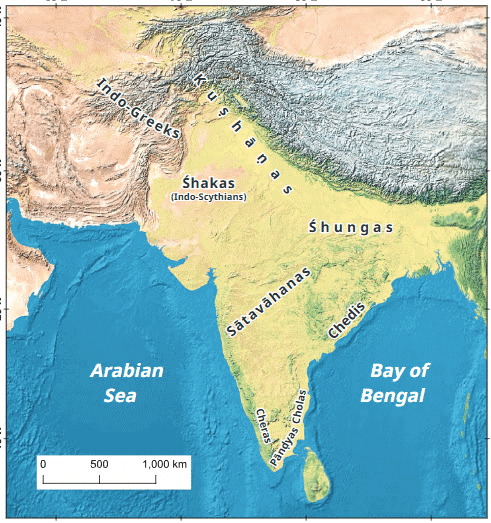 Prominent Dynasties during Reorganisation
Prominent Dynasties during Reorganisation
- Breakup of the Maurya Empire: After Ashoka’s death, the Maurya Empire fragmented due to weak successors and internal conflicts. As a result, many regions that were once part of the empire gained independence or were reduced to smaller kingdoms.
- Emergence of New Kingdoms: Several new kingdoms and dynasties emerged in this period, many of them previously tributary states under the Mauryas. These new kingdoms competed with each other for territorial control and power.
- Cultural and Economic Reorganisation: Along with political changes, this period also witnessed a rise in art, literature, and cultural exchanges. The introduction of new coins, architecture, and religious practices marked the economic and cultural reorganisation of the subcontinent.
Thus, the term "Age of Reorganisation" reflects the dynamic shifts in political, economic, and cultural realms during this era.
Q2: Write a note on the Sangam literature in 150 words.
Ans: Sangam literature refers to the earliest collection of Tamil poetry, which was created during the Sangam period (approximately 2nd century BCE to 3rd century CE). It is a significant part of ancient Tamil culture, showcasing a diverse range of themes and emotions, reflecting the society of that time.
 Sangam Period
Sangam Period
Themes in Sangam Literature:
- The literature is divided into two main categories: Aham (internal or emotional themes such as love and relationships) and Puram (external themes like heroism, valor, and war).
- Aham poems explore personal feelings and the complexities of human relationships.
- Puram poems focus on public life, valor, generosity, and societal values.
Cultural Insight:
Sangam literature offers a window into the social structure, values, and beliefs of ancient Tamil society. It also highlights the role of kings, warriors, merchants, and common people in the kingdom.
Overall, Sangam literature is not just a collection of poems but a historical record of life, culture, and the evolving social fabric of South India.
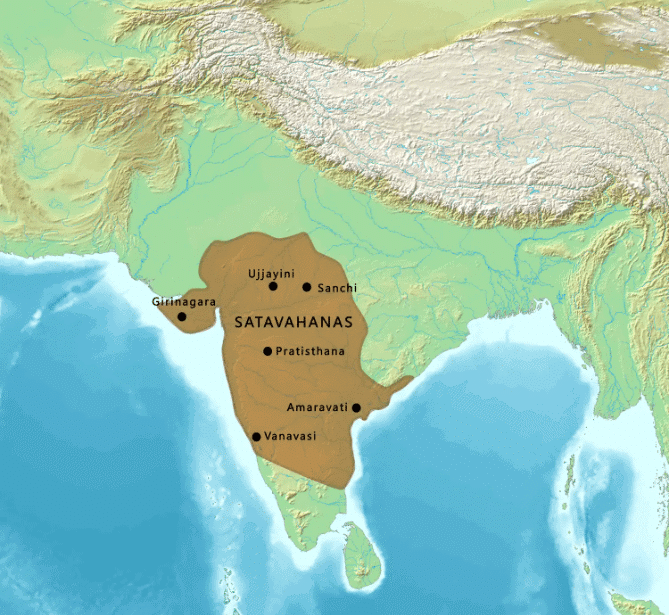 SatavahanasQ3: Which rulers mentioned in this chapter included their mother’s name in their title, and why did they do so?
SatavahanasQ3: Which rulers mentioned in this chapter included their mother’s name in their title, and why did they do so?
Ans: In this chapter, one of the rulers who included his mother’s name in his title was Gautamīputra Sātakarṇi of the Sātavāhana dynasty. He was named after his mother, Gautamī Balaśhri. This practice was symbolic of the prominent role mothers played in the royal family and society.
Significance of the Practice:
- By including his mother's name, the ruler emphasized the respect and acknowledgment of the maternal lineage in the royal family.
- It was a sign of the queen mother's influence on the king’s reign, indicating her importance in the governance and decision-making process of the kingdom.
Cultural Context:
- This practice also reflected the matrilineal significance in royal families, where the mother’s role in maintaining and supporting the kingdom was seen as vital.
- It showed the king’s respect for his mother’s contributions, particularly in nurturing and guiding him during his rise to power.
Q4: Write a note of 250 words about one kingdom from this chapter that you find interesting. Explain why you chose it.
Ans: The Sātavāhana Kingdom is one of the most interesting kingdoms mentioned in this chapter. The Sātavāhanas ruled over the Deccan Plateau, which is modern-day Andhra Pradesh, Telangana, and Maharashtra. The kingdom rose to prominence due to its strategic location, economic prosperity, and strong trade networks.
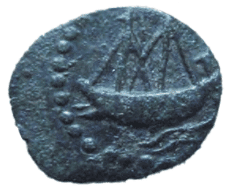 Satavahana Coin
Satavahana Coin
Economic and Cultural Prosperity:
- The Sātavāhanas controlled vital trade routes connecting the north and south of India. Their economy was largely based on agriculture, especially in the fertile regions around the Krishna-Godavari river system.
- Maritime trade played a significant role, with Sātavāhana coins depicting ships, highlighting their advanced shipbuilding techniques. These coins have been found as far as Roman Empire territories, showcasing the kingdom’s commercial reach.
Religious and Cultural Contributions:
- The Sātavāhanas patronized various religious traditions, including Buddhism, Jainism, and Vedic rituals. They built several Buddhist caves, such as the Naneghat Caves in Maharashtra, used for toll collection and rest stops for traders.
- Their support for literature and art led to the flourishing of Sangam literature in Tamil Nadu and other cultural expressions.
Why I Chose This Kingdom:
I find the Sātavāhana Kingdom interesting because of its economic prosperity, cultural contributions, and inclusive approach to various religious and cultural traditions. The fact that it flourished through trade and supported artistic endeavors makes it a unique example of a prosperous kingdom in ancient India. Their integration of different cultures and support for education and art remains a fascinating aspect of their rule.
Q5: Imagine you have the chance to create your own kingdom. What royal emblem would you choose, and why? What title would you take as the ruler? Write a note about your kingdom, including its values, rules and regulations, and some unique features.
Ans: I would choose the Phoenix as my royal emblem, symbolizing rebirth, resilience, and the ability to rise from challenges. My title would be “Sovereign of the Eternal Flame”, symbolizing the endless pursuit of knowledge, growth, and strength.
- Kingdom’s Values and Principles: Justice, equality, and compassion would be the core values of my kingdom. Everyone, regardless of their status, would have equal rights and opportunities to thrive. The welfare of the people would be prioritized, ensuring education, healthcare, and fair trade.
- Rules and Regulations: Laws would ensure environmental protection, with strict rules on conservation and sustainable development. There would be an emphasis on law and order, with transparency in governance and a fair judicial system.
- Unique Features: The kingdom would be self-sustaining, with a green economy based on renewable resources. Cultural diversity would be celebrated through annual festivals, which would include performances from different communities. Public health would be a major focus, with free medical care available to all citizens.
- Why This Kingdom: I would focus on building a kingdom that is prosperous, inclusive, and sustainable, with the welfare of people as its top priority.
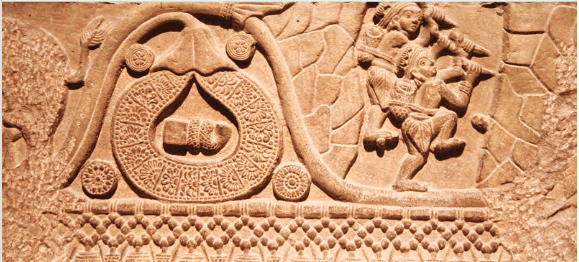
Panel from Bharhut Stupa
Q6: You have read about the architectural developments of the post-Maurya era. Take an outline of the Indian subcontinent and mark the approximate locations of some of the ancient structures mentioned in this chapter.
Ans: Key Ancient Structures from the Post-Maurya Era:
- Bharhut Stūpa: Located in Madhya Pradesh, known for its beautifully carved railings and Buddhist relief sculptures.
- Naneghat Caves: Situated near Pune, Maharashtra, used for toll collection and trade rest stops.
- Udayagiri and Khandagiri Caves: Located in Bhubaneswar, Odisha, famous for their rock-cut architecture and inscriptions.
- Sanchi Stūpa: Found in Madhya Pradesh, originally built by Ashoka and later expanded during the Śhunga dynasty.
- Karla Caves: Located near Lonavala, Maharashtra, known for their Buddhist rock-cut architecture and grand entrance pillars.
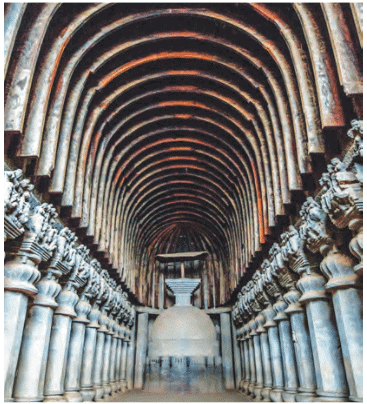
- Karla Caves
Locations on the Indian Map:
- Bharhut Stūpa and Sanchi Stūpa are located in central India (Madhya Pradesh).
- Naneghat Caves and Karla Caves are located in western India (Maharashtra).
- Udayagiri and Khandagiri Caves are located in eastern India (Odisha).
These locations highlight the spread of architectural and cultural developments across India during the post-Maurya period.
|
23 videos|204 docs|12 tests
|
FAQs on NCERT Solutions for Class 7 Social Science Chapter 6 The Age of Reorganisation
| 1. What were the main reasons for the reorganization of states in India during the 1950s and 1960s? |  |
| 2. How did the States Reorganization Act of 1956 impact the political landscape of India? |  |
| 3. What role did the Linguistic Reorganization Commission play in the formation of new states? |  |
| 4. What were the challenges faced during the reorganization of states in India? |  |
| 5. How did the reorganization of states affect the development of regional identities in India? |  |
















